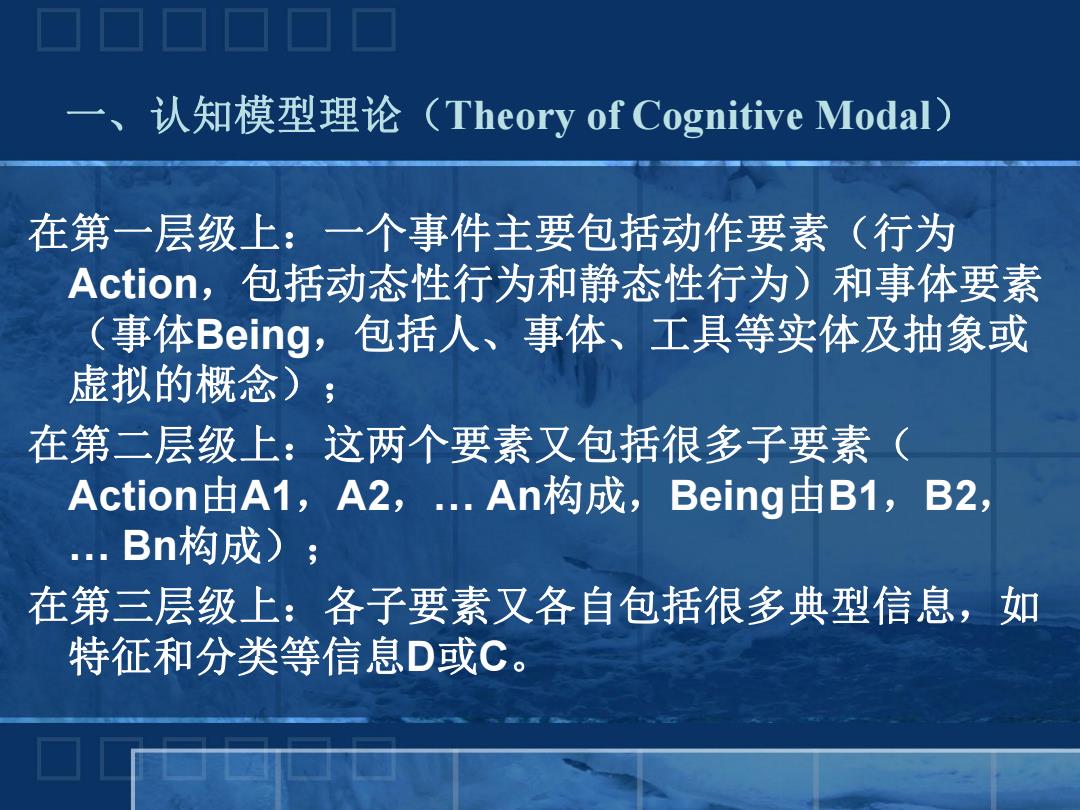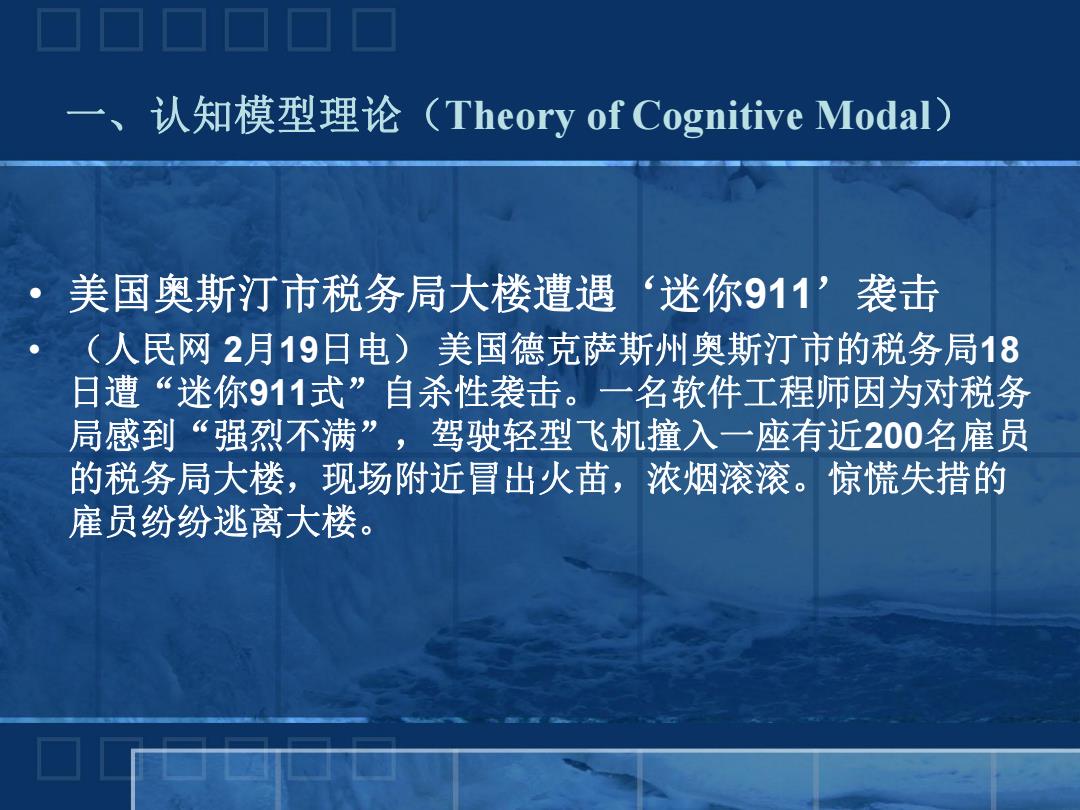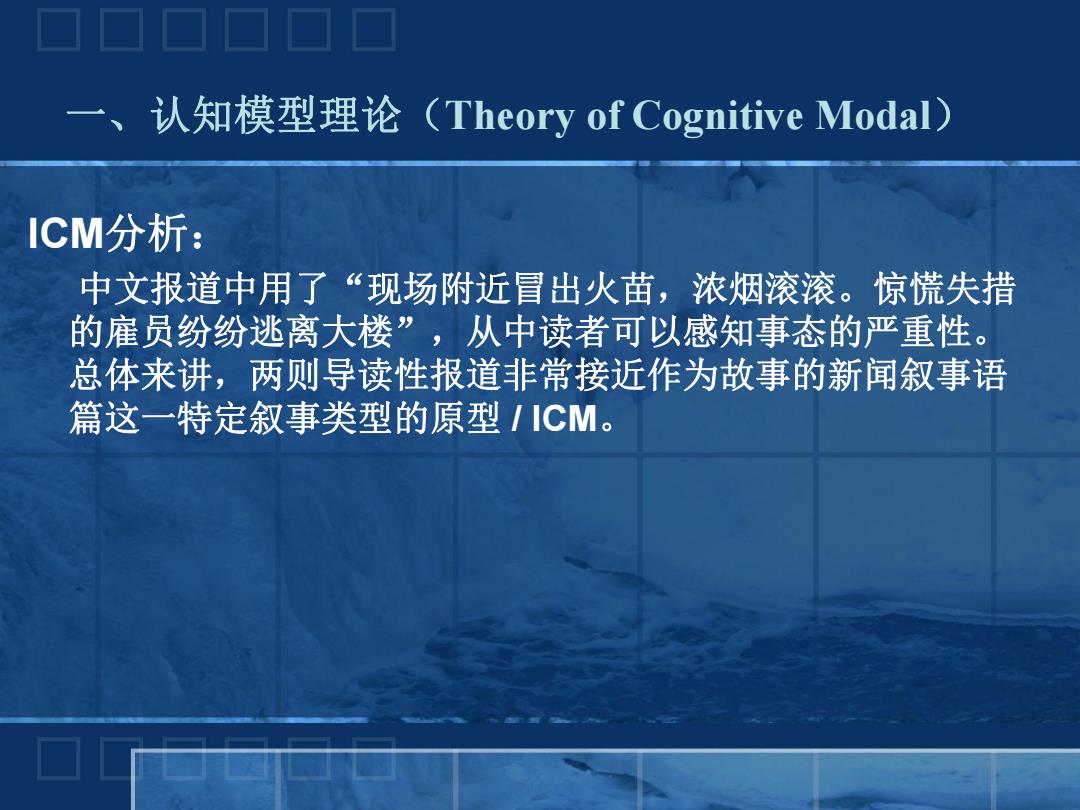
一、 认知模型理论(Theory of Cognitive Modal), 在第一层级上:一个事件主要包括动作要素(行为 Action,包括动态性行为和静态性行为)和事体要素 (事体Being,包括人、事体、工具等实体及抽象或 虚拟的概念) 在第二层级上:这两个要素又包括很多子要素 Action由A1,A2,.An构成,Being由B1,B2, .Bn构成); 在第三层级上:各子要素又各自包括很多典型信息,如 特征和分类等信息D或C
在第一层级上:一个事件主要包括动作要素(行为 Action,包括动态性行为和静态性行为)和事体要素 (事体Being,包括人、事体、工具等实体及抽象或 虚拟的概念); 在第二层级上:这两个要素又包括很多子要素( Action由A1,A2,… An构成,Being由B1,B2, … Bn构成); 在第三层级上:各子要素又各自包括很多典型信息,如 特征和分类等信息D或C。 一、认知模型理论(Theory of Cognitive Modal)

一、 认知模型理论(Theory of Cognitive Modal)) An example:《纽约时报》(2010.2.18)和人民网头 版(2010.2.19)对发生在美南部德克萨斯州首府奥斯汀 市飞机撞楼事件的导读性报道: Man Crashes Plane Into Texas I.R.S.Office AUSTIN,Tex.-Leaving behind a rant against the government,big business and particularly the tax system,a computer engineer smashed a small aircraft into an office building where nearly 200 employees of the Internal Revenue Service were starting their workday Thursday morning,the authorities said
• An example: 《纽约时报》(2010.2.18)和人民网头 版(2010.2.19)对发生在美南部德克萨斯州首府奥斯汀 市飞机撞楼事件的导读性报道: • Man Crashes Plane Into Texas I.R.S. Office • AUSTIN, Tex. — Leaving behind a rant against the government, big business and particularly the tax system, a computer engineer smashed a small aircraft into an office building where nearly 200 employees of the Internal Revenue Service were starting their workday Thursday morning, the authorities said. 一、认知模型理论(Theory of Cognitive Modal)

一、 认知模型理论(Theory of Cognitive Modal). 美国奥斯汀市税务局大楼遭遇‘迷你911’袭击 (人民网2月19日电)美国德克萨斯州奥斯汀市的税务局18 日遭“迷你911式”自杀性袭击。一名软件工程师因为对税务 局感到“强烈不满”,驾驶轻型飞机撞入一座有近200名雇员 的税务局大楼,现场附近冒出火苗,浓烟滚滚。惊慌失措的 雇员纷纷逃离大楼
• 美国奥斯汀市税务局大楼遭遇‘迷你911’袭击 • (人民网 2月19日电) 美国德克萨斯州奥斯汀市的税务局18 日遭“迷你911式”自杀性袭击。一名软件工程师因为对税务 局感到“强烈不满” ,驾驶轻型飞机撞入一座有近200名雇员 的税务局大楼,现场附近冒出火苗,浓烟滚滚。惊慌失措的 雇员纷纷逃离大楼。 一、认知模型理论(Theory of Cognitive Modal)

一、 认知模型理论(Theory of Cognitive Modal) ICM分析: 英汉导读性报道满足了作为故事的新闻叙事的ICM中的不同CM: Who一a computer engineer/一名软件工程师; What一smashed a small aircraft into an office building/驾驶轻型飞机撞 入一座税务局大楼; When-Thursday morning/18日; Where-一AUSTIN,Tex./美国德克萨斯州奥斯汀市; Why-against the government,big business and particularly the tax system/对税务局感到“强烈不满”; HowI结果)比较模糊,英文报道中用了“smashed a small aircraft into an office building”,其中smashed一词对撞楼结果有一定暗示
ICM分析: 英汉导读性报道满足了作为故事的新闻叙事的ICM中的不同CM: Who—a computer engineer / 一名软件工程师; What—smashed a small aircraft into an office building / 驾驶轻型飞机撞 入一座税务局大楼; When—Thursday morning / 18日; Where—AUSTIN, Tex. / 美国德克萨斯州奥斯汀市; Why—against the government, big business and particularly the tax system / 对税务局感到“强烈不满” ; How / 结果)比较模糊,英文报道中用了“smashed a small aircraft into an office building” ,其中smashed一词对撞楼结果有一定暗示。 一、认知模型理论(Theory of Cognitive Modal)

一、 认知模型理论(Theory of Cognitive Modal) ICM分析: 中文报道中用了“现场附近冒出火苗,浓烟滚滚。惊慌失措 的雇员纷纷逃离大楼”,从中读者可以感知事态的严重性。 总体来讲,两则导读性报道非常接近作为故事的新闻叙事语 篇这一特定叙事类型的原型I1CM
ICM分析: 中文报道中用了“现场附近冒出火苗,浓烟滚滚。惊慌失措 的雇员纷纷逃离大楼” ,从中读者可以感知事态的严重性。 总体来讲,两则导读性报道非常接近作为故事的新闻叙事语 篇这一特定叙事类型的原型 / ICM。 一、认知模型理论(Theory of Cognitive Modal)